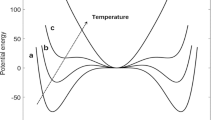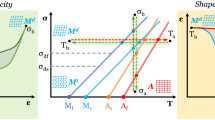Abstract
This paper systematically illustrates the deformation and damping mechanism of magnetic shape memory alloy (MSMA) and builds a damping mathematical model by using a single-degree-of-freedom vibration system. The results indicate that absorbed damping is proportional to the quadratic of external force and inversely proportional to the overall mass, the natural frequency and the total damping of the system when the system is in resonance. At the same time, the paper calculates the relative power and draws the stress–strain curve of mechanical property. The relations among temperature, stress, intensity of magnetic induction, and deformation of MSMA are studied through a static experiment. Meanwhile, an analysis of the damping characteristic indicates that the external force is 25–30 N when the temperature ranges from 23 to 29 °C and that the deformation rate is the largest and the damping performance is the best at a magnetic induction strength of 0.55 T.









Similar content being viewed by others
References
Z. Peng, X. Jin, Y. Fan et al., Internal friction and modulus changes associated with martensitic and reverse transformations in a single crystal Ni48.5Mn31.4Ga20.1 alloy. J. Appl. Phys. 95(11 II), 6960–6962 (2004)
W.H. Wang, G.D. Liu, G.H. Wu, Magnetically controlled high damping in ferromagnetic Ni52Mn24Ga24 single crystal. Appl. Phys. Lett. 89(10), 3 (2006)
I. Suorsa, E. Pagounis, Magnetic field-induced stress in the Ni–Mn–Ga magnetic shape memory alloy. J. Appl. Phys. 95(9), 4958–4961 (2004)
Q.X. Zhang, F.X. Wang, Study on magnetic shape memory effect and external properties of Ni2MnGa alloy. Rare Metal Mater. Eng. 34(8), 1263–1266 (2005)
C.L. Tan, Y.W. Huang, X.H. Tian et al., Origin of magnetic properties and martensitic transformation of Ni-Mn-In magnetic shape memory alloys. Appl. Phys. Lett. 100(13), 132402 (2012)
L. Chen, Study on Damping Capacity and Mechanical Properties of the Mn-rich Mn Ni Based Alloys (Nanchang University, Nanchang, 2016)
P.H. Fu, H.H. Pang, F. Gao, Damping capacity of several high strength magnesium alloys. Spec. Cast. Nonferrous Alloys 33(7), 593–596 (2013)
F.Y. Wang, Damping Mechanism of Al–Zn Alloys and the Influence of Damping Performance Factors (Southwest Jiao Tong University, Chengdu, 2017)
G.Y. Song, L. Mu, Summary of kinds and features of damping alloys. Noise Vib. Control 8(4), 97–99+109 (2010)
S. Ding, Study on damping properties of Fe–Mn Alloy (Sichuan University, Chengdu, 2007)
H.M. Han, Study on the Mechanical Properties of Shape Memory Alloy Dampers (Xi’an University of Architecture and Technology, Xi’an, 2008)
C. Shearwood, R.B. Yates, Development of an electromagnetic micro-generator. Electron. Lett. 33(22), 1883–1884 (1997)
J. Pons, V.A. Chernenko, R. Santamarta, E. Cesari, Crystal structure of martemsitic phases in Ni–Mn–Ga shape memory alloys. Acta Mater. 48, 3027–3038 (2000)
A.A. Likhachev, A. Sozinov, K. Ullakko, Influence of external stress on reversibility of magnetic-field-controlled shape memory effect in Ni–Mn–Ga. Proc. SPIE 4333(2001), 197–206 (2001)
Y. Li, Research on Vibration Energy Harvester Based on MSMA Intellgent Materials (Shenyang Aerospace University, Shenyang, 2017)
Z. Peng, X. Jin, Y. Fan et al., Internal friction and modulus changes associated with martensitic and reverse transformations in a single crystal Ni48.5Mn31.4Ga20.1 alloy. J. Appl. Phys. 95(11 II), 6960–6962 (2004)
V.G. Gavriljuk, O. Soderberg, V.V. Bliznuk et al., Martensitic transformations and mobility of twin boundaries in Ni2MnGa alloys studied by using internal friction. Scr. Mater. 49(8), 803–809 (2003)
C. Segui, E. Cesari, J. Pons et al., Internal friction behavior of Ni–Mn–Ga. Mater. Sci. Eng. A Struct. Mater. Prop. Microstruct. Process 370(1-2), 481–484 (2004)
Author information
Authors and Affiliations
Corresponding author
Rights and permissions
About this article
Cite this article
Qingxin, Z., Qihang, F., Luping, W. et al. Research and Experimental Analysis of Damping Characteristics of Magnetic Shape Memory Alloy. Trans. Electr. Electron. Mater. 19, 272–278 (2018). https://doi.org/10.1007/s42341-018-0047-3
Received:
Revised:
Accepted:
Published:
Issue Date:
DOI: https://doi.org/10.1007/s42341-018-0047-3




